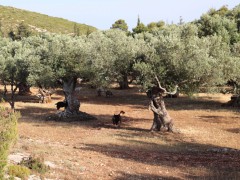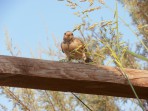Nature on the island of Zakynthos

The Greek island of Zakynthos impresses especially with its beautiful nature, freshness, variety of plants and animals and turquoise sea. In particular, the island thrives on thermophilic plants, colourful flowers and various herbs. The name 'island of scents' or 'island of flowers' thus rightly belongs to Zakynthos. Rare marine animals, such as the common sea bream and the Mediterranean seal, also live here.
Geography and climate of Zakynthos
The Greek island of Zakynthos lies in the Ionian Sea, off the western coast of the Peloponnese peninsula. Zakynthos is the southernmost of the Ionian Islands and is characterised by its Mediterranean climate. Summers on the island are sunny and dry, while winters are mild and rainy. Most of the rainfall in this area falls between October and March, providing the island with enough moisture to allow it to turn green and beautifully covered with a variety of flowers and herbs in spring. Zakynthos is thus referred to as the 'green island'.
Geographically, the island of Zakynthos is very diverse. The northern and north-western part of the island is mainly mountainous and rocky, and the highest mountain, Vrachionas, is located here, with an altitude of 756 m. The coastline is lined with cliffs and steep cliffs, which often form very interesting rock formations or beautiful sea caves. The so-called blue caves, fascinating limestone caves and arches inside which the sea glows azure blue, are found around the northern tip of Zakynthos - the most beautiful ones are on the north-eastern side from the port of Agios Nikolaos to Cape Skinari and on the north-western coast near the village of Volimes. Another symbol of Zakynthos, the bay of Navagio with the wreck of an old ship, can also be found on the northwest coast of the island.
The southern and south-eastern part of Zakynthos, on the other hand, is mostly flat. Thanks to sufficient humidity and temperature, the lowlands are very fertile and allow the island to produce especially good quality wine and olive oil, but also many kinds of tasty fruit and vegetables and aromatic herbs. The southern and south-eastern coasts are dotted with beautiful sandy beaches and coves with clear blue sea, such as the beautiful Laganas Bay, one of the most popular tourist areas of the island, but also an area that is important for the protection of the natural wealth of Zakynthos.
The Greek island of Zakynthos lies in a seismically active area and minor earthquakes are quite frequent. In 1953, however, a very destructive earthquake measuring 7.2 on the Richter scale struck the island, with its epicentre at the southern edge of the neighbouring island of Cephalonia. The earthquake and subsequent fires caused extensive damage to Zante, with the capital Zante devastated and many important monuments destroyed. A strong earthquake also hit Zakynthos relatively recently, in 2018. Although the earthquake had a magnitude of 6.8 and was very felt, it fortunately did not cause much damage, mainly due to strict building regulations for new constructions.
Island of flowers - flora of Zakynthos
In terms of flora, Zakynthos is most beautiful in spring, when nature awakens and the whole island blooms. In particular, the low shrubs of myrtle, holly and laurel thrive here. Not to be missed are the magnificent magnolias in bloom, whose intoxicating scent attracts not only bees. If you close your eyes and try to take in the scent of nature, you will also smell various herbs, such as thyme and sage.
In the south-eastern part of the island in particular, there are green hills covered with hibiscus and orchids, while tulips and potato plants are also often seen. The eastern coast of the island is characterised by large olive and citrus groves, as well as banana, prickly pear and agave trees.
Thanks to the abundance of colourful flowers and incredibly fragrant herbs, Zakynthos is also known as the "island of fragrance"or the "island of flowers". This name dates back to the Venetian rule, when the Venetians referred to Zakynthos as the 'flower of the east'.
Protected Loggerhead sea turtle (Caretta Caretta) - fauna of Zakynthos
The symbol of Zakynthos is the protected Caretta Caretta turtle, which nests in Laganas Bay but can be seen in the sea around the island. They are often referred to as "sea turtles", but unlike traditional sea turtles, they have a much stronger head and powerful jaws, and can also be recognised by their reddish-brown colouration. Caretta caretta is a protected species. An interesting feature of this species is that the female turtles lay their eggs in the same place where they hatched themselves, which is why the protection of the beaches in the south of the island is so important. A special regime applies to the beaches of Laganas Bay, including Laganas, Kalamaki, Gerakas, and the adjacent islands of Marathonisi and Strofades.
However, the common bream is not the only rare species found on Zakynthos. The Monachus monachus (Mediterranean seal) also lives on the coast and in the sea around the island . It can be seen more off the western coast of the island, where there are rocky outcrops and underwater caves. Most Monachus seals live on the small island of Pelouzo, which is also in Laganas Bay. However, tourists are not allowed on Pelouzo, precisely because of the protection of this endangered species.
The Ionian Sea around Zakynthos is very clean, so that in addition to the giant duck and the Mediterranean seal, dolphins can also be spotted. Tuna, cod and rays are abundant in the sea around the island , but in general the fish in the sea are very much affected by uncontrolled fishing.
Moving to the mainland of Zakynthos, small mammals, mainly rodents, are the main inhabitants, with lizards and geckos often seen in the wild. The island is also home to several species of snakes and turtles. Every visitor to the island can think of free-ranging goats, but we can also see horses, which are kept mainly for tourist rides.
Zakynthos is also home to many species of birds, including birds of prey, and wading birds live in the lagoon area of Limni Keri. Migratory birds rest on the island during their journey to Africa.
The Zakynthos National Marine Park (established in 1999) is responsible for the protection of the island's natural heritage and the specific species that live there. The National Marine Park covers a large area in the southern part of Zakynthos, stretching from Cape Marathia through Limni Keri, Laganas and Kalamaki beaches to Gerakas beach. The protection zone also includes the adjacent sea area and the small islands of Strofada, even the southern inland area of the island. The protected species are mainly giant ducks and Mediterranean seals, but of course there are many more species of birds, reptiles, amphibians and mammals.
Other natural attractions of Zakynthos
The Ionian Sea offers excellent conditions for diving and observing the diverse underwater life around the shores of Zakynthos. Zakynthos even ranks among some of the best dive sites in Europe. There are various rock reefs, underwater caves and other underwater formations hiding under the water, including octopuses and moray eels. Divers also have a better chance of spotting the protected Caretta Caretta turtle.
Off the south-eastern tip of the island is the deepest site in the Mediterranean, the Inous Sinkhole, which reaches a staggering depth of 4,500 metres.
The main source of income for the inhabitants of Zakynthos is tourism, but due to the excellent climatic conditions, agriculture also thrives here. The main exports from the island are olives, olive oil, grapes, wine and citrus fruits, as well as almonds, pistachios and figs.
Did you visit this place and do you have some additional informations, interessting observation or photos?















